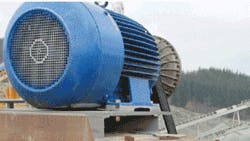Torque Motors in Material Handling
In many gravel pits and stone-crushing plants, shaft and belt drives provide motive power for conveyor belts. In fact, until recently, this was the situation at the gravel plant of NorStone AS, Tau, Norway — until the facility switched to gearmotors, to reduce cost and boost reliability. NorStone supplies aggregates for concrete and asphalt and pipe cover gravel for coastal regions; each year its facilities produce more than 6.6 million tons of gravel, 2.3 million tons from the Tau plant.
Back to direct drive
Direct-drive gearmotors were actually common in stone-crushing material-handling applications in the 1980s, but over the years, many plants changed to belt drives — because spare parts for these were always available. In contrast, quick availability of stock and spare gearmotor parts is relatively new. “Now, service and spare parts for gearmotors are available quickly. We hold some parts in stock ourselves, and NORD Drivesystems (with NORD Gear Corp. Midwest in Waunakee, Wis.) supplies the rest,” explains Ivar Ullestad, maintenance manager at Tau. “Direct drive leads to higher reliability, which means less downtime, lost production, and maintenance,” he adds.
Goodbye wear
Many of the locations for material-handling conveyor belt drives are open and unprotected; due to harsh weather conditions (including wind, rain, and sleet, as well as the dusty environment at the site) repair and maintenance is best kept to a minimum for maintenance staff. The Tau plant runs seven days a week, 24 hours a day in shift operation. 168 production hours include 16 hours of scheduled maintenance. The plant is shut down for a winter break, during which annual inspection and overhaul tasks are performed in two to three weeks.
Here, direct drives have boosted reliability approximately 4.5% in the last three years. “By replacing shaft and belt drives with direct-driving NORD gearmotors, we eliminate belt wear, which is considerable. Furthermore, no water or dust can enter the drive mechanism,” says Per Thu, production manager at NorStone.
The relative investment for purchasing new gear units is also lower: The cost of replacing a complete package (with shaft-type gear unit, belt pulleys, belts, shed, belt cover, and motor) is higher than that of a comparable geared motor.
Finally, with the majority of drives converted to direct driving, “We are standardizing motor size, shaft size, and drum diameter to limit diversity and simplify maintenance, stock management, and service,” Ullestad says.
For more information, visit nord.com.
